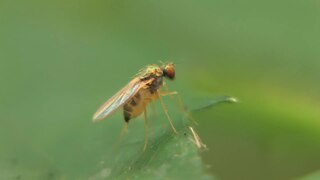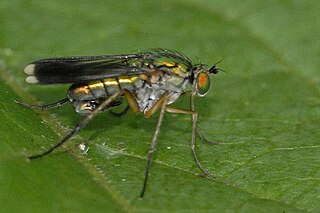Cheiromyia is a genus of flies in the family Dolichopodidae. It is found in the Neotropical realm. It was originally named Cheirocerus by Octave Parent in 1930, but was renamed to Cheiromyia by C. E. Dyte in 1980 after it was found to be preoccupied by the catfish genus Cheirocerus.

Chrysotimus is a genus of longlegged flies in the family Dolichopodidae. It is cosmopolitan in distribution, but it is probably paraphyletic with respect to several genera of limited distribution.
Diostracus is a genus of flies in the family Dolichopodidae.
Nepalomyia is a genus of flies in the family Dolichopodidae.
Phalacrosoma is a genus of flies in the family Dolichopodidae. The genus was synonymized with Hercostomus by Scott E. Brooks (2005), but it is considered valid in Igor Grichanov's checklist of the family.

Rhaphium is a genus of flies in the family Dolichopodidae. It is the largest genus within the subfamily Rhaphiinae, with over 200 species currently known.
Sybistroma is a genus of flies in the family Dolichopodidae. It includes over 50 species, described mainly from the Palaearctic and Oriental realms. A single species is known from the Afrotropical realm. Until 2005, the genus was thought to be restricted to the Mediterranean in distribution, with five known species. It was recently expanded to include the former genera Hypophyllus, Ludovicius and Nordicornis, as well as some species of Hercostomus.
Teuchophorus is a genus of flies in the family Dolichopodidae.
Thambemyia is a genus of fly in the family Dolichopodidae. It known from the Oriental and Neotropical realms, with a single Palearctic species from Japan. Conchopus is sometimes considered a synonym of the genus.

Dolichopodinae is a subfamily of flies in the family Dolichopodidae.

Gymnopternus is a genus of flies in the family Dolichopodidae. It was formerly placed as a subgenus of Hercostomus, but is now accepted as a separate genus.

Poecilobothrus is a genus of flies in the family Dolichopodidae.
Parathalassiinae is a subfamily of flies in the family Dolichopodidae. It is part of an expanded concept of the family, Dolichopodidae sensu lato, and forms a monophyletic group with Dolichopodidae sensu stricto. It was once placed provisionally in the subfamily Microphorinae as the tribe Parathalassiini.
Neothalassius is a genus of flies in the family Dolichopodidae from Chile. It was recorded by Brooks & Cumming (2011) from the region, but was undescribed until 2016.
Eothalassius is a genus of flies in the family Dolichopodidae.
Chimerothalassius is a genus of flies in the family Dolichopodidae. It contains two described species, one from New Zealand and one from the Caribbean. It also contains three undescribed species, two from New Zealand and one from Costa Rica.
Conchopus is a genus of flies in the family Dolichopodidae. It is sometimes considered a synonym of Thambemyia.

Heleodromia is a genus of flies in the family Empididae.
Microphorella is a genus of flies in the family Dolichopodidae. It is currently considered both paraphyletic and polyphyletic, and several species groups may need to be recognised as subgenera or genera.





